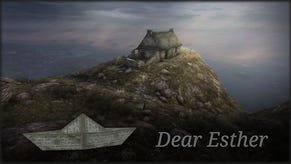Wot I Think: Dear Esther
Lonely Island
I come to Dear Esther completely blind. For some reason I've chosen to read nothing about it at any point, perhaps instinctively opting to preserve myself against knowing everything about at least one game before I get to play it. I've heard the overwhelmingly positive, and grumbles of hype and overrated content, and I have an idea that it's a game about exploring over anything else. But that's all I know. So from this position, having never played the 2008 mod, here's Wot I Think.
An island, a brief, esoteric introduction narrated by a man writing to an Esther, explaining that the island is uninhabited, and the ability to move. That's where I begin. There's two things that catch my eye. A radio tower in the distance, with a blinking red light, and a lighthouse right next to me. As everyone with their brain in place knows, lighthouses are magic, so I wander over.
At which point I learn that I am apparently not in the possession of any arms. Esther's barren themes extend to its controls, and the lack of even an 'interact' button is striking. Interesting, certainly, but also a peculiarity when the very first building presents you with a closed door, a door handle, and no way to even rattle it. Then you quickly learn that this game's restrictive grammar is even more draconian, when a small rock on the ground anyone could step over is impassable, as you apparently move by gliding across flat surfaces, and there's no jump. Find a game's control mechanisms in this way is always frustrating, of course. It's not, "Oh, I can do this!" It's, "Oh, I can't do that."
It quickly becomes apparent that this isn't an open island to explore, but rather some very well disguised tight corridors. That's fine, but you do quickly start to feel funnelled, especially when the blockades are quite so slight. And while the details are amazing, the island gorgeous, a dated aspect of the Source engine becomes naggingly consistent - all the foliage, which exists in abundance, is 2D, turning to face you as you move. Which means, as you walk down the overgrown paths, there's the deeply uncanny experience of all the plants turning their gaze to follow you as you walk past.
Of course, not having any arms makes swimming pretty tricky, and despite there being a binding for "swim up", it doesn't do anything. If you're exploring in the sea, you'll just drown. (Other areas it works fine.)
But slowly, the further I got, the more it made sense. It's pretty much the moment you enter the caves that what Dear Esther wants to be comes to the foreground, and you accept it for what it is. There's no use button because you're meant to be on this inexorable path, and the game simply wants to tell you its story.
The caves are stunning. Just utterly stunning. While the whole island is meticulously detailed and extremely pretty, the caves are something else, masterfully lit and so intricately crafted, that I found myself taking screenshots not to illustrate the review, but to set as my desktop background. Photographs for a frame, rather than images for a website. And here the corridor is justified, the story becomes more intensely told, and the mysteries finally present themselves. This central act sets you up for the final third, asks you all the questions you'll then want to be answered.
Which does rather leave the first act as somewhat problematic. By not establishing its own nature early on, Dear Esther becomes about accepting limitations, rather than enjoying its structure. It never gets any less frustrating that you can't walk up a gentle slope, or step past a pebble, because - well - games have taught us for too long that we can, and if that rule gets broken, the fourth wall is broken, and the fifth, sixth and seventh walls start boxing us in.
The writing is genuinely good. While it may sometimes slip close to the hackneyed, for the most part its telling is extremely strong, cleverly blurring the line between metaphoric poetry and simple conflation. The weakness, perhaps, is once you've had the, "Oh, I see!" moment, you've nothing further to gain, the point just becoming belaboured rather than further established. But Dear Esther exists only to tell that story, and in this it succeeds, accompanied by the gorgeously painted background of its island. It's also accompanied by some absolutely beautiful music, sparingly used and perfectly haunting, strings and piano doubling the atmosphere.
At an hour and a half long, the $10 tag seems pretty high to me, especially for a game that has no reason to be played twice. It's certainly a novel experience, but it's one I think artificially limits itself, perhaps even with a hint of hubris. At my most cynical I'd suggest it's maybe a touch infatuated with itself, to the point of forgetting how it might be approached by the new player. Your arms are tied behind your back from the start, because dammit, listen to the story you. Is that story good enough to justify this? That's up to you. For me, no, not quite.
Disclaimer: Dear Esther's PR has been provided by occasional RPS contributor, Lewis Denby. This has, of course, had no conscious influence on my article.




















